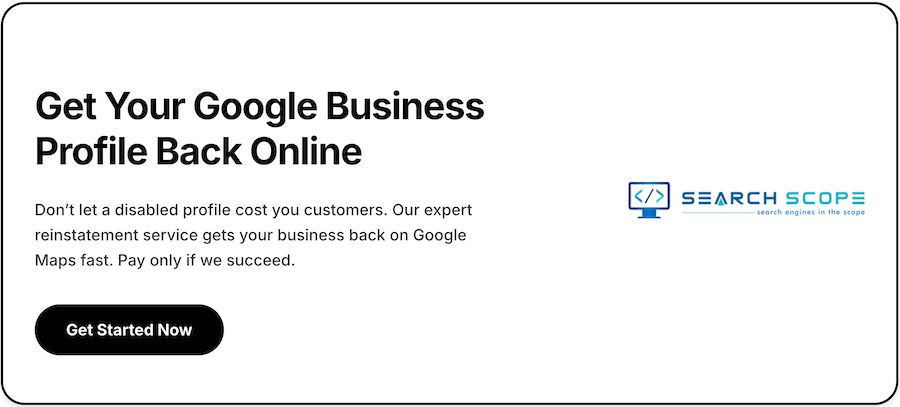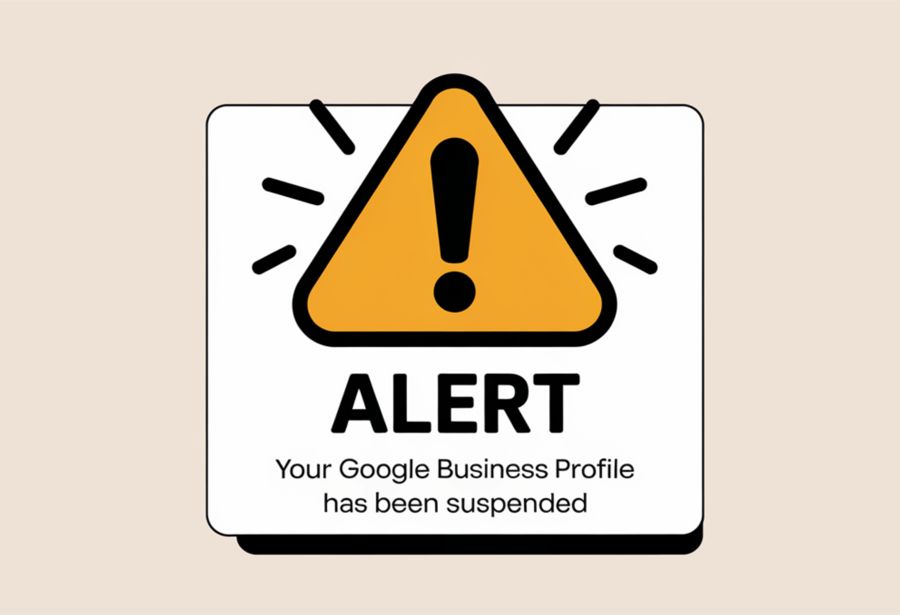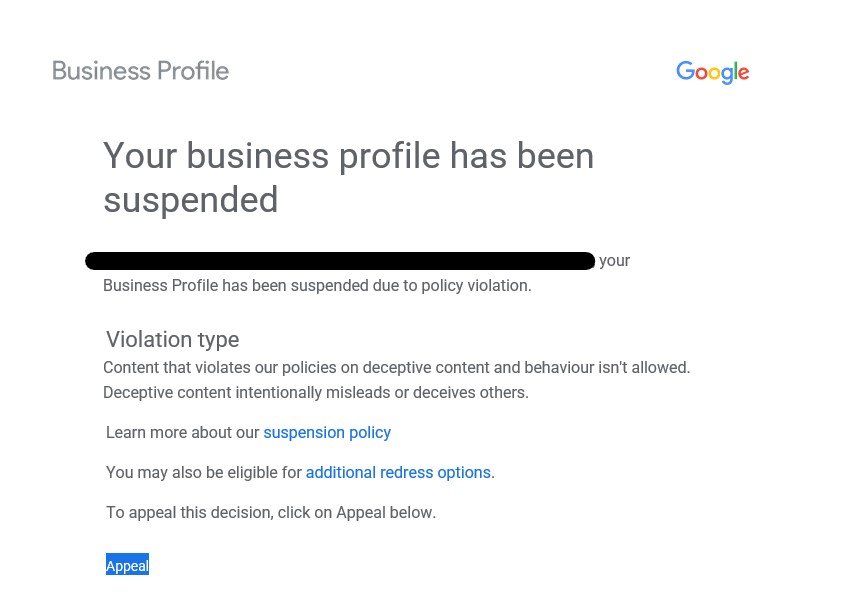Why Your Google Business Profile Got Suspended and How You Can Fix It

Last Updated on 3 October 2025 by Dorian Menard
You’ve probably seen it happen. A business is getting a steady stream of calls and website clicks, then suddenly, it all stops. That sinking feeling hits when you check Google Maps and realise their profile has completely vanished. This is the reality of a Google Business Profile suspension, and it’s happening more frequently as Google’s AI cracks down on policy violations.
We’ve worked with many Australian business owners to navigate this exact problem. Getting your profile back online is possible, but it requires a careful, strategic approach. This guide is designed to give you that strategy, explaining exactly why profiles get suspended and providing a clear, step-by-step process to get your business reinstated.
Here’s what you need to know to get started:
- Identify the Cause: Understand the common triggers, from incorrect business details to keyword stuffing.
- Gather Your Evidence: Prepare essential documents like business licenses, utility bills, and photos of your signage.
- Submit a Clean Appeal: Use Google’s official appeals tool correctly the first time to avoid delays.
- Prevent Future Issues: Learn how to maintain your profile to stay compliant with Google’s guidelines.

If you need professional help, click here to get started with our Google Business Profile reinstatement service.
Why is your Google Business Profile suspended?
Google suspends Business Profiles for many reasons, and the assessment is almost always handled by its automated AI systems. These algorithms are designed to protect users from spam and inaccurate information, but they can sometimes flag legitimate businesses by mistake.
1. Incorrect or Inconsistent Business Details
Keeping your business’s Name, Address, and Phone number (NAP) consistent across the web is fundamental to local SEO. When Google’s crawlers find conflicting information, it sends a major red flag that can trigger a suspension.
This isn’t just an SEO issue, it’s about customer trust. A 2023 BrightLocal study found that 76% of consumers would be unlikely to use a business if they found incorrect or inconsistent contact details online.
| Information Type | Common Issues That Cause Suspensions | Typical Impact |
|---|---|---|
| Business Name | Using variations, abbreviations, or adding keywords. | High risk of suspension. |
| Address | Using a P.O. box, virtual office, or an unstaffed location. | High risk of hard suspension. |
| Phone Number | Listing different numbers on various online directories. | Can trigger a soft suspension. |
| Operating Hours | Showing inaccurate or outdated opening times. | Usually a warning, then suspension. |
For example, I recently worked with a landscaping company that was suspended after changing from a storefront to a service-area business. They updated their address on the profile but didn’t complete the new verification process, which caused the system to flag their account.
Even a tiny error, like abbreviating “Street” to “St.” on one platform but not another, can contribute to a negative quality score. Use a tool like BrightLocal or Semrush’s Listing Management tool to audit your NAP consistency across major directories.
“Google often suspends profiles for even minor mistakes.” – Digital Division
If your business operates from your home, you must set it up as a service-area business and hide your address. Attempting to display a residential address as a physical storefront is a common and fast track to suspension.
2. Breaching Google’s Rules
Violating Google’s guidelines can get your profile suspended without warning. These rules exist to ensure every listing is accurate, honest, and provides value to the user.
Some industries face much greater scrutiny from Google because they are frequently targeted by spammers. These high-risk categories include lawyers, locksmiths, plumbers, garage door repair services, and HVAC technicians. If your business is in one of these fields, expect that any appeal process will likely take longer as it will require a more thorough manual review.
“Google suspends listings for various reasons, especially if you are violating Google Business Profile Guidelines.” – Search Engine Journal

Common violations include using a misleading business name, misrepresenting your services, or posting prohibited content. Google’s automated systems and user reports are constantly scanning for these issues.
How to Stay Compliant
- Stay Accurate: Keep your business information updated and truthful.
- Act on Warnings: If you get a warning email from Google, address the issue immediately and document the changes you make.
- Perform Regular Audits: Check your profile monthly to make sure it still aligns with Google’s policies.
If you do get suspended, you can appeal through Google’s reinstatement process. Just be prepared for it to take several weeks, during which your business will be invisible on Maps and in local search results.

3. Fake or Bought Reviews
Posting fake reviews is a serious violation of Google’s terms of service and often results in an immediate suspension. This includes buying positive reviews for your business or posting fake negative reviews on a competitor’s profile.
Google’s systems are very effective at detecting this kind of activity. The AI looks for specific red flags that signal review manipulation.
Common Red Flags for Fake Reviews:
- Sudden Spikes: A business that normally gets two reviews a month suddenly gets 20 in a day.
- Geographic Mismatches: A local Perth cafe receiving dozens of reviews from accounts based in another country.
- Reviewer History: The reviewer has no profile history or has left identical reviews for multiple unrelated businesses.
- IP Address Patterns: Multiple reviews originating from the same IP address or a known review farm.
Google’s official policy is clear on this. It states that reviews are only valuable when they are honest and unbiased.
“Reviews are only valuable when they are honest and unbiased. We don’t allow fake reviews and take steps to prevent them.” – Google Support
If your profile is suspended due to fake reviews, Google may remove all your reviews, even the genuine ones. To get reinstated, you’ll have to prove the legitimacy of your business through the formal appeal process.
4. Overusing Keywords in Business Name
Adding extra keywords to your business name, known as keyword stuffing, is a direct violation of Google’s guidelines. This tactic involves adding service types or locations to your name that aren’t part of your legally registered business name.
An example would be changing “Johnson’s Plumbing” to “Best 24/7 Emergency Plumber Perth – Johnson’s”. While it might seem like a smart SEO move, it risks suspension and makes your business look unprofessional.
Based on industry observations, here’s a common breakdown of how Google handles this:
- 60% of cases may receive an initial warning, forcing you to correct the name.
- 20% can result in a soft suspension where you lose management access.
- 20% may lead to a hard suspension, removing your profile entirely.
“Including unnecessary information in your business name is not permitted, and could result in your Business Profile being suspended.” – Google My Business Guidelines
Google identifies keyword stuffing with its algorithms, manual reviews, and reports from users, including those in the Local Guides program. A Moz study from a few years ago found that keywords in the business name were a significant ranking factor. While that’s still true, Google has become much more aggressive in penalising businesses that try to manipulate this.
The only compliant way to leverage this is to legally register a business name or a “trading as” name that includes your target keywords. For example, registering as “Bayswater Emergency Plumbers” is perfectly fine if that’s your official trading name.
5. Duplicate Business Listings
Having more than one Google Business Profile for the same physical location is against the rules and often leads to suspension. This usually happens when a business moves, rebrands, or an employee creates a new profile without realising one already exists.
Creating separate listings for different services at the same address is also a violation. A plumbing company, for instance, cannot create one profile for “drain cleaning” and another for “hot water systems” if both operate from the same location.
As local SEO expert Joy Hawkins, owner of Sterling Sky, points out, this tactic is also self-defeating.
“Duplicate listings usually filter each other due to the Possum update so having multiple listings means that they are competing for the same spot”
Duplicate listings cause several key problems. They split your reviews and ranking signals between two profiles, confusing both Google and your potential customers. This ultimately weakens your online authority and reduces your visibility in search results.
If you find duplicate listings, you must claim them both and then contact Google Business Profile support to request they be merged. We offer a professional citation cleaning service to find and resolve these issues as part of our local SEO campaigns.
6. Using Virtual Offices or P.O. Boxes
Google’s guidelines are very clear. Your business address must be a physical location that your customers can visit and where your staff are present during stated business hours.
This means P.O. boxes and most virtual offices are not compliant. Using an address from a provider like Regus or Servcorp can be risky unless you lease a dedicated, staffed office with permanent signage. A simple mail-forwarding service is not enough.
“Per the Google My Business guidelines, virtual offices are not allowed unless staffed during the business hours.”
This rule is in place to stop businesses from creating fake listings in cities where they have no physical presence. As of 2025, Google has also become much stricter about using residential addresses for storefront businesses.
| Location Type | Is it Compliant? |
|---|---|
| Virtual Office | Only if it has permanent signage and is staffed by your team during business hours. |
| P.O. Box | Never allowed. |
| Home Address | Only for service-area businesses, and the address must be hidden from the public. |
| Co-working Space | Risky. You need a dedicated, private office, not just a hot desk. |
If you run your business from home, you must register as a service-area business and hide your address. In your profile settings, you can then specify up to 20 suburbs or postcodes that you serve. Trying to pass off a home address as a retail shop is a direct path to suspension.

7. Sudden Major Profile Changes
Making significant changes to core information on your Google Business Profile can trigger an automatic review or suspension. Google’s algorithms are trained to see sudden, drastic updates as a potential sign of a hijacking attempt or spammy behaviour.
The highest-risk changes are to your business name, address, and primary business category. Changing your phone number or website URL also carries a moderate risk.
| Profile Element | Risk Level for Suspension |
|---|---|
| Business Name | Very High |
| Primary Category | High |
| Address/Location | High |
| Phone Number | Medium |
| Website URL | Medium |
| Business Hours | Low |
A common mistake I see is a business owner logging in after six months and trying to update everything at once. This is a huge red flag for Google. If you need to make multiple changes, it’s safer to spread them out over a few weeks.
“I think anytime you change name, address or phone, it triggers some type of moderation or review or at the very least puts up a red flag.” – Colan from Local Search Forum
When you do make a major change, like moving your business, be prepared for a re-verification request. This could involve a postcard, phone call, or even a video verification. It’s also critical to monitor your profile for any “suggested edits” made by other users, as accepting an incorrect edit can also cause issues.
8. Prohibited Content or Services
Google maintains strict policies about the types of content and services that can be promoted on its platform. Any business that deals in prohibited categories risks immediate and often permanent suspension.
This is to ensure the platform remains safe and trustworthy for all users. The rules cover illegal products, dangerous goods, and other restricted items.
| Content/Service Type | Examples | Suspension Risk |
|---|---|---|
| Illegal Products & Services | Counterfeit goods, endangered animal products, unauthorised pharmaceuticals. | Immediate & Permanent |
| Dangerous Products | Weapons, ammunition, explosives, recreational drugs. | Immediate |
| Adult Content & Services | Explicit material, escort services. | High |
| Hate Speech & Offensive Content | Content that promotes discrimination or violence. | High |
| Misleading Information | Making false claims or engaging in deceptive practices. | High |
Google uses a combination of automated scanning and manual reviews to enforce these policies. High-risk industries such as firearms dealers, gambling operators, and adult entertainment venues are watched especially closely.
It’s also important to be aware of policies around user-generated content. For instance, Google’s review policy prohibits businesses from offering discounts or free items in exchange for reviews.
“Content that has been incentivized by a business in exchange for discounts, free goods and/or services” is prohibited. – Google Review Policy
To stay compliant, regularly review all content on your profile, including photos, posts, and Q&As. Ensure all your services are legal, accurately represented, and adhere to Google’s content standards.
9. Inactive or Unresponsive Business
A neglected Google Business Profile is a liability. If a profile shows signs of being abandoned, Google may suspend it to prevent outdated information from misleading users.
This policy became more prominent after Google’s 2023 update, which tightened rules around account management. A profile that hasn’t been logged into or updated for an extended period, often over a year, is at risk.
Common signs of neglect that can trigger a suspension include:
- Going more than 12-18 months without any updates or logins.
- Ignoring customer questions posted in the Q&A section for months.
- Having outdated information, such as incorrect holiday hours.
- Failing to respond to a re-verification request from Google.
When a profile is suspended for inactivity, it disappears from Google Search and Maps. This means your business becomes invisible to potential customers searching for your services.
How to Keep Your Profile Active
To avoid an inactivity suspension, you need to show Google that your profile is actively managed. Make it a routine to log in at least once every couple of months.
Simple actions like publishing a new post, uploading a photo, or responding to a review signal to Google that the business is still operating. An active, well-managed profile is far less likely to be flagged by Google’s automated systems.
10. Reports from Users or Competitors
Anyone can suggest an edit or report a violation on a Google Business Profile. This crowd-sourcing feature helps Google maintain accuracy, but it can also be abused by competitors or disgruntled customers.
When a report is filed, it can trigger a manual review by Google’s support team. If they find a violation, it can lead to suspension.
Common reasons for user reports include:
- Inaccurate Information: A user reports that your business address is incorrect or your hours are wrong.
- Fake Reviews: A competitor reports a suspicious spike in your 5-star reviews.
- Policy Violations: Someone notices you’ve stuffed keywords into your business name and reports it.
- Spammy Listings: A user reports that your listing is for a non-existent business or a lead-generation service.
Google takes these reports seriously and will investigate the claims. In some cases, this can take several weeks, and your profile may be suspended during the investigation.
“Google wants to ensure users have access to consistent high-quality search results. Ultimately, this benefits everyone involved… cleaner search results lead to more streamlined user experiences.”
To protect your profile, regularly monitor it for any unauthorised changes. Respond quickly and professionally to all customer reviews and questions. By maintaining a clean, accurate, and compliant profile, you’ll be in a much stronger position to dispute any false reports filed against you.
Types of Suspensions: Soft vs. Hard
It’s also important to understand the two types of suspensions. A soft suspension means your profile is still visible on Google, but you’ve lost the ability to manage it. This is often caused by a minor violation or a pending re-verification.
A hard suspension is more serious. This is when your profile is completely removed from Google Search and Maps. This is the most common type and usually results from a significant policy violation.

Preparing to Resolve a Google Business Profile Suspension
Once you’ve identified the likely reason for the suspension, your next step is to prepare for the reinstatement appeal. This is not something you want to rush.
Start by carefully reading the official Google Business Profile guidelines. You need to fix any and all violations on your profile *before* you submit an appeal. Submitting an appeal for a profile that is still in violation will result in an automatic denial.
We created a custom Google Business Profile suspension GPT assistant to help with this. You can paste your profile details into it, and the assistant will help you spot potential violations based on Google’s documentation.
Collect Required Evidence
You need to gather strong evidence to prove your business is legitimate and operates as described in your profile. You only have 60 minutes to upload your documents once you start the appeal form, so have everything ready in advance.
Your documentation must be clear, legible, and consistent. The business name and address must exactly match what is on your profile. Essential documents include:
- Business Registration: Your ABN/ACN registration from ASIC showing the business name and principal place of business.
- Proof of Address: A recent utility bill (gas, electricity, water, internet) in the business’s name at the listed address.
- Photos of Your Location: Clear images of your physical storefront with permanent signage. For service-area businesses, photos of your work vehicle with branding are crucial.
- Proof of Operation: A business license, insurance certificate, or invoices showing you conduct business at that location.
How to Submit a Suspension Appeal to Google
Once you’ve fixed all violations and gathered your evidence, it’s time to request a review from Google. The only way to do this is through their official channel.
Log into the Google Account connected to your Business Profile and go to the Google Business Profile appeals tool. If you manage multiple profiles, ensure you select the correct suspended one.
Tips for Submitting Evidence
How you present your evidence matters. Organise your files clearly and ensure they directly address the reason for the suspension.
| Document Type | What Google Looks For |
|---|---|
| Business Registration | Proof of a legitimate, active business registered with the Australian government. |
| Utility Bills | Recent bills (last 90 days) that confirm you operate at the business address. |
| Photo Evidence | High-quality images showing your permanent signage at your physical location. |
| Video Evidence | A continuous video showing the outside of your building, your entrance, and your workspace. This is often required for re-verification. |
Combine all your evidence into a single, well-organised submission. Do not submit multiple appeals, as this will only confuse the system and delay your case.
“First-time requests typically take 5-7 business days for review, though Google officially states it may take up to 2 weeks for a response”.
If your initial appeal is denied, don’t panic. You can use the form called “Request additional review of a denied appeal”. These follow-up requests are often reviewed more quickly, sometimes within 24-72 hours. Our team at Search Scope recently reinstated a client’s profile in under 24 hours using this exact form.
sbb-itb-c74901f
After Submitting the Appeal
Once you’ve submitted your appeal, the waiting game begins. You can track the status of your appeal in the appeals tool, which will show if it’s “In progress,” “Appealed,” or “Not approved.”
The standard review timeline is about 5-7 business days, but this can stretch to two weeks or longer, especially for high-risk industries or during busy periods. Be patient and avoid the temptation to submit another appeal while the first one is under review.
Dealing with Rejected Appeals
Getting your appeal denied is frustrating, but it’s not the end of the road. You need to figure out what went wrong and build a stronger case for your next submission.
| Step | Action to Take |
|---|---|
| Review the Rejection | Carefully read the denial email. Sometimes it contains a clue about the specific policy you violated. |
| Analyse Your Profile Again | Compare your profile against Google’s guidelines with a fresh pair of eyes. There might be a violation you missed. |
| Gather More Evidence | Strengthen your case with additional documentation. If you didn’t submit a video before, record one now. |
| Submit a Follow-Up Appeal | Use the “Request additional review” form to submit your new, stronger case. |
Common reasons for rejection include providing insufficient evidence, not fully fixing the original violation, or having information that doesn’t exactly match your official documents. If you’re stuck after multiple rejections, it may be time to consult with professionals who specialise in Google Business Profile management.

Preventing Future Google Business Profile Suspensions
Getting your profile reinstated is only half the battle. The next step is to protect it from future suspensions.
This means adopting a proactive approach to profile management. Regular audits and a commitment to following Google’s guidelines are essential for long-term stability.
Keep Information Accurate and Updated
Always ensure your profile information is correct and consistent everywhere it appears online. Set a calendar reminder to review your profile quarterly. Check your business hours, contact details, and service areas for accuracy.
Document every change you make and keep verification records in a safe place. This will be invaluable if you ever face another issue.

Avoid Common Errors
Steer clear of the common mistakes that trigger suspensions. Never create duplicate profiles, be truthful in all your business details, and stay informed about Google’s ever-changing guidelines.
One pro-tip I share with all my clients is to avoid making too many edits at once. Logging in once a year to update everything is a sure way to trigger a suspension. From my experience, it’s now safer to make changes to core details from the front end, using the “Suggest an edit” feature on Google Maps, rather than from the backend dashboard.
“The key to preventing suspensions is maintaining consistent information across all platforms while strictly adhering to Google’s guidelines. Regular audits and immediate corrections of any discrepancies are essential for long-term profile stability.”
Restoring and Protecting Your Google Business Profile
Getting a Google Business Profile suspension reversed requires a methodical approach. It’s about identifying the violation, collecting the right documents, and submitting a clean, well-prepared appeal through the proper channels.
The review process takes patience, as it can last from a few days to several weeks. Before you submit your appeal, double-check that your profile is fully compliant with all of Google’s guidelines.
Remember, you only have 60 minutes to complete the appeal form once you start, so preparation is everything. Gather your business licenses, utility bills, and other proof of legitimacy beforehand.
“Compliance is essential to protect the profile from suspensions and to maintain trust with Google and potential customers. Non-compliance can lead to suspensions, which can negatively impact a business’s online visibility and reputation.”
If your first attempt is denied, don’t give up. Analyse the rejection, gather stronger evidence, and use the “Request additional review of a denied appeal” form. Once you are reinstated, the work isn’t over. Implement a schedule for regular profile audits to ensure you remain compliant and avoid future problems.
Partnering with Experts for Google Business Profile Management
Managing a Google Business Profile, especially after a suspension, can be complex and time-consuming. An agency with expertise in local SEO can help you navigate the process and protect your online presence.
Our business profile reinstatement services at Search Scope are built on years of experience with Google’s guidelines. We handle compliance audits, appeal preparation, and ongoing management to minimise your risk.
| Aspect | Benefits of Professional Management |
|---|---|
| Prevention | Regular compliance checks and profile optimisation to reduce suspension risks. |
| Resolution | Expert handling of appeals, evidence gathering, and violation analysis. |
| Maintenance | Ongoing updates and review management to adhere to Google’s policies. |
The main advantage of working with seasoned SEO professionals is their deep understanding of Google’s rules. They can ensure your profile is not only compliant but also optimised to attract more customers.
When choosing an agency, look for one that offers thorough audits, proven success in resolving suspensions, and ongoing monitoring. For businesses in Western Australia, a local expert can provide an extra edge
by understanding the regional market.
Managing Your Google Business Profile
Successfully managing your Google Business Profile comes down to attention to detail and a commitment to compliance. By focusing on a few key areas, you can protect your profile and maintain a strong online presence.
Prioritise accuracy by ensuring your business details are consistent everywhere online. Encourage genuine feedback from your customers to build a trustworthy review profile. Most importantly, keep your profile information aligned with your official business registration documents.
If your profile is suspended, act quickly. Review the suspension notice, correct any violations, gather your supporting documents, and submit a detailed reinstatement request to Google.
While reinstatement is usually possible, prevention is always the best strategy. At Search Scope, we are an Australian SEO agency that specialises in Google Maps SEO, compliance, and reputation management. We can help keep your profile healthy so you can focus on attracting new customers.
FAQs
Why did Google suspend my business profile?
Google typically suspends a profile for violating its guidelines. The most common reasons include having incorrect or inconsistent business information across different platforms, or engaging in prohibited practices like keyword stuffing in your business name or using a virtual office as your address.
Suspensions can be “soft” (where you lose management access but the profile remains visible) or “hard” (where the profile is completely removed). To get reinstated, you must provide clear documentation to prove your business is legitimate.
FAQs
Steps to Unsuspend Your Google Business Profile
If your Google Business Profile is suspended, the first step is to log into the associated Google account. From there, navigate to the Google Business Profile appeals tool and select the suspended profile.
Review the violation details, then submit your appeal with all the required evidence within the 60-minute time limit. Google’s review typically takes 5-7 business days but can sometimes extend to two weeks. If your appeal is denied, correct any remaining issues, gather more evidence, and submit a follow-up request using the “Request additional review of a denied appeal” form.

